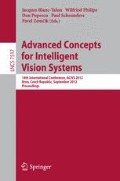Abstract
In human eyes, many clues are used to perceive depth. For nearby tasks involving eye-hand coordination, depth from vergence is a strong cue. In our research on humanoid robots we study binocular robotic eyes that can pan and tilt and perceive depth from stereo, as well as depth from vergence by fixing both eyes on a nearby object. In this paper, we report on a convergent robot vision set-up: Firstly, we describe the mathematical model for convergent vision system. Secondly, we introduce an algorithm to estimate the depth of an object under focus. Thirdly, as the centers of rotation of the eye motors do not align with the center of image planes, we develop an active calibration algorithm to overcome this problem. Finally, we examine the factors that have impact on the depth error. The results of experiments and tests show the good performance of our system and provide insight into depth from vergence.
Access this chapter
Tax calculation will be finalised at checkout
Purchases are for personal use only
Preview
Unable to display preview. Download preview PDF.
References
Bandera, C., Scott, P.D.: Foveal Machine Vision System. In: IEEE International Conference on System, Man and Cybernetics, USA, vol. 2, pp. 596–599 (1989)
Hansard, M., Horaud, R.: Cyclorotation Models for Eyes and Cameras. IEEE Transactions on Systems, Man, and Cybernetics 40(1), 151–161 (2010)
Wodnicki, R., Roberts, G.W., Levine, M.D.: A foveated image sensor in standard CMOS technology. In: Proceedings of the IEEE Custom Integrated Circuits Conference, USA, pp. 357–360 (1995)
Wang, Z., Member, S., Bovik, A.C.: Embedded Foveation Image Coding. IEEE Transactions on Image Processing 10, 1397–1410 (2000)
Weber, C., Triesch, J.: Implementations and Implications of Foveated Vision. Recent Patents on Computer Science 2(1), 75–85 (2009)
Bernardino, A., Santos-Victor, J.: A Binocular Stereo Algorithm for Log-Polar Foveated Systems. In: Bülthoff, H.H., Lee, S.-W., Poggio, T., Wallraven, C. (eds.) BMCV 2002. LNCS, vol. 2525, pp. 127–136. Springer, Heidelberg (2002)
Ude, A., Gaskett, C., Cheng, G.: Foveated Vision Systems with two Cameras per Eye. In: International Conference on Robotics and Automation, FL, pp. 3457–3462 (2006)
Olson, T.J., Coombs, D.J.: Coombs: Real-Time Vergence Control for Binocular Robots. International Journal of Computer Vision 7(1), 67–89 (1991)
Gould, S., Arfvidsson, J., Kaehler, A., Sapp, B., Messner, M., Bradski, G., Baumstarck, P., Chung, S., Ng, A.Y.: Peripheral-foveal vision for real-time object recognition and tracking in video. In: Proceedings of the 20th International Joint Conference on Artifical Intelligence, USA, pp. 2115–2121 (2007)
Björkman, M., Eklundh, J.-O.: Foveated Figure-Ground Segmentation and Its Role in Recognition. In: British Machine Vision Conference, pp. 57–88 (2005)
Sahabi, H., Basu, A.: Analysis of Error in Depth Perception with Vergence and Spatially Varing Sensing. Computer Vision and Image Understanding 63(3), 447–461 (1996)
Scharstein, D., Szeliski, R.: A Taxonomy and Evaluation of Dense Two-Frame Stereo Correspondence Algorithms 47(1-3), 7–42 (2002)
Li, M.: Kinematic calibration of an active head-eye system. IEEE Transactions on Robotics and Automation 14(1), 153–158 (1998)
Fusiello, A., Trucco, E., Verri, A.: A compact algorithm for rectification of stereo pairs. Machine Vision and Applications 12(1), 16–22 (2000)
Trucco, E., Verri, A.: Introduction Techniques for 3-D Computer Vision. Prentice Hall, Upper Saddle River (1998)
Zhang, Z.: A flexible new technique for camera calibration. IEEE Transactions on Pattern Analysis and Machine Intelligence 22(11), 1330–1334 (2000)
Author information
Authors and Affiliations
Editor information
Editors and Affiliations
Rights and permissions
Copyright information
© 2012 Springer-Verlag Berlin Heidelberg
About this paper
Cite this paper
Wang, X., Lenseigne, B., Jonker, P. (2012). Depth from Vergence and Active Calibration for Humanoid Robots. In: Blanc-Talon, J., Philips, W., Popescu, D., Scheunders, P., Zemčík, P. (eds) Advanced Concepts for Intelligent Vision Systems. ACIVS 2012. Lecture Notes in Computer Science, vol 7517. Springer, Berlin, Heidelberg. https://doi.org/10.1007/978-3-642-33140-4_3
Download citation
DOI: https://doi.org/10.1007/978-3-642-33140-4_3
Publisher Name: Springer, Berlin, Heidelberg
Print ISBN: 978-3-642-33139-8
Online ISBN: 978-3-642-33140-4
eBook Packages: Computer ScienceComputer Science (R0)

